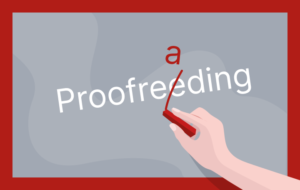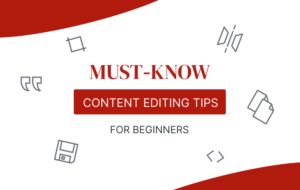Editing and proofreading are critical steps in creating high-quality content. When it comes to writing, spelling, punctuation, syntax, and grammar are all crucial. They have a massive impact on the reader’s experience while reading the content. Readers can quickly get bored if any of these elements are missing.
By addressing spelling and grammar errors, syntax and plagiarism in the final copy, you’ll ensure that the content of your paper is not just good but fantastic! In this article, we’ll share some excellent tips for editing and proofreading any work faster and with less hassle.
But what is proofreading and editing, and what’s the difference between them? You might ask. Read on to find out!
Editing and proofreading in writing process
Editing and proofreading are critical steps in the writing process. Editing involves improving the paper’s content, organisation and style by altering sentence structure and word choice while proofreading focuses on removing grammar, spelling, punctuation and other mistakes.
What’s the difference between editing and proofreading?
Simply put, editing is the act of refining what an author writes. Proofreading, on the other hand, serves as a safety net, ensuring that the writer does not overlook anything. These steps are different in their core but have the same goal: making content readable and error-free.
All clear with editing, but why is proofreading important?
Errors can unintentionally alter the content. For example, misspelling a word or omitting an apostrophe can radically affect the meaning of your sentence, making the content say something entirely different than what was initially intended. That is why proofreading is crucial.
Now that you know what editing and proofreading are and their difference, let’s move on to the top tips for proofreading and editing any work, from essays to blog posts and dissertations.
14 proofreading tips and tricks for error-free copy

Proofreading demands a substantial time investment and attention to detail, but it is well worth it in the long run. Here are 14 tips to get you started.
1. Keep the project-specific instructions and style guide close at hand.
You cannot properly proofread unless you know basic grammatical rules and style guidelines. Even the most experienced writers will use a print or web resource when necessary. Purdue University’s Online Writing Lab is a good place to start.
2. Take your time to focus on the job and avoid distractions.
Thorough proofreading is detailed work that requires hours of time and focus. Doing it well is hard if you are in a rush or constantly interrupted. So, set aside time before your deadline and find a quiet spot to do the job. You can also get a set of earplugs for added convenience.
3. Zoom in the text for a different feel.
When proofreading, experiment with viewing your page at 200% or higher. Individual letters stand out as the words take up more of the screen, making it easier to see typos and errors.
4. Change the page’s layout.
It’s simple to skip words in a line of text that spans the entire width of your page. Set two-inch margins on your page’s right and left sides to read fewer words per line. A similar effect can be achieved by splitting the copy into two columns.
5. Read out loud but slowly.
Every word catches your attention when you read the text aloud while doing it slowly helps you examine each letter and sentence. If you start speeding up, you will more likely be looking at groups of words only.
6. Use grammar checker software.
Checking your content with specialised software like Grammarly can save you a block of time. However, remember that online software, no matter how good it is, cannot catch all errors, and you must still decide whether the suggestions provided are correct.
7. Watch for commonly made mistakes in punctuation.
Commas are one of the most often used punctuation marks, yet it can be challenging to use them correctly. Get acquainted with comma usage guidelines so you can properly position them in your writing.
8. Check the meaning of words.
Keep an eye out for homonyms, which have the same sound but different meanings. People frequently mix up the words “affect” with “effect” in their writing.
9. Strive for accuracy.
In addition to proofreading for typos, subject-verb agreement, grammar and style, devote some time to fact-checking to ensure the names of people, places and organisations are accurate.
10. Check quotations and sources.
When quoting, it is critical not to change other people’s ideas. If you decide to tidy up a quote by removing words or clarifying meaning, be sure to use ellipses and square brackets. Plus, always make certain that all quotes are attributed to the correct source.
11. Examine numbering.
When there is numbering in a document, mistakes are easily made. Inspect all numbered chapters, sections, headings, and lists carefully to ensure sequential numbering.
12. Check the footnotes and endnotes.
Make sure that each superscript has a corresponding reference in the body text. All endnotes and footnotes should always be formatted consistently.
13. Check that the links work.
Click each link in the document to determine that it is not broken and directs readers to the relevant web page.
14. Establish a proofreading routine.
Not all of the proofreading techniques work well for every writer. Experiment with various strategies to find the ones that work best for you. The most important thing is to create a routine so that thorough proofreading becomes a habit.
You might also find useful: Assignment writing help
10 essential tips for editing writing

Are you ready to become better at editing? You may not have access to a professional editor, but you can utilise the below editing techniques in writing to enhance the quality of your work, so dive in!
1. Take a rest before you begin editing.
It’s easy to overlook mistakes when looking at the same content for a long time, so rest before beginning the editing process. This will help your brain relax and reset, allowing you to return to work with fresh eyes and easily recognise areas for improvement.
2. Check the structure first.
When you start editing, prioritise the structure of your content. Ensure your writing flows logically and each point ties to the next effortlessly. Look for and rectify errors in style, tone or language.
3. Keep an eye out for consistency.
When it comes to good copy editing, consistency in everything from style to format is essential. If you use the Oxford comma in one sentence, apply it consistently throughout the entire document.
4. Maintain simplicity.
Effective communication entails delivering your message as clearly as possible. Avoid complex vocabulary or technical jargon that your readers may not understand. Instead, communicate your ideas using plain language and short sentences. This will not only make your text easier to read, but it will additionally improve its impact.
5. Remove uncertainty.
Avoid wishy-washy sentences to sound authoritative. When you use terms like “could be a reason for” or “seems to be,” you appear uncertain, and your message weakens.
6. Avoid repetition.
Try not to rely on specific phrases to make your point. Instead, strive for variety. Use a word frequency counter to identify repetition and a thesaurus to find synonyms.
7. Eliminate filler words.
Find redundant words and phrases by searching for “there,” “here,” and “it” in your word processor.
For example:
It is fun to copy-edit your manuscript.
Vs.
Editing your manuscript is fun.
8. Remove weak adjectives.
Weak adjectives might also hurt your writing. When describing pronouns and nouns, use strong adjectives and avoid words like “very” and “really.”
9. Get rid of weak “to be” verbs.
Using various versions of the verb “to be” can make the words that follow weaker. So, make sure to replace “is,” “am,” “are,” “were,” “was,” “been” and “being” with stronger alternatives.
Example of a weak sentence: We are not enjoying editing.
Example of a strong sentence: We hate editing.
10. Know when to call it a day.
Finally, understand when it’s time for you to stop editing. While ensuring that your work is free of errors is critical, obsessively nitpicking every detail might lead to diminishing returns. At some point, you have to trust that you have done your best and let go of the task.
Last but not least, keep indulging in proofreading and editing practice and trying new techniques. Over time, you’ll learn to deliver flawless content like a pro. However, should you feel overwhelmed, don’t hesitate to step back and hire a qualified editor at a cheap essay writer service like royalessays.org. All you need is clear instructions and a stable internet connection to get the process started!

